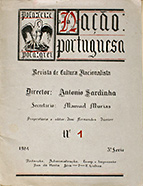

................................
The emergence of Lusitanian Integralism is immediately linked to the publication, on 8 April 1914 in the city of Coimbra, of the magazine Nação Portuguesa [Portuguese Nation], which became its great theoretical and doctrinal organ (its first periodical had been Alma Portugueza – Órgão do Integralismo Lusitano – Revista de philosophia, literatura e arte , sociologia , educação , instrução e actualidades [Alma Portugueza - Organ of " Integralismo Lusitano" – Magazine of philosophy, literature and art, sociology, education, instruction and current affairs], published in 1913 in only two issues.
Nação Portuguesa had the subtitle Revista de filosofia política [Magazine of political philosophy] in its 1st edition. At the top of the magazine's front page is an image of a pelican tearing the flesh from its breast to feed its children and the mottoes of King João II ("Pola Lei e pola Grei"). After the subtitle, each one of the issues contains a table of contents. In 1922, starting from the 2nd edition, this magazine became the property of Sociedade Integralista Editora under the name " Revista de Cultura Nacionalista " [Nationalist Culture Magazine] and was published in Lisbon.
It was made available in the city of Coimbra, and its administrative headquarters were located in Rua das Flores n.º 12. The edition was organised by the renowned França & Arménio editorial house. The price of a single issue was 200$00. With a subscription, the cost was 2$00 in Portugal and 3$00 abroad. From 1926 onwards, the subscription conditions were as follows: Mainland, Islands, and Spain 60$00; Portuguese colonies 72$00; Brazil 80$00; Foreign countries £1; Single issue 6$00 and back issues 7$00. The following were the agents of Nação Portuguesa : Guimarães- Magazine Gil Vicente ; Porto- António Álvaro Dória; Lobito- Eusébio Soares; Huambo- António Pais Pinheiro de Figueiredo; Beira- Luís Ribas; New Bedford- António Augusto Lopes; Tauton - António Gil Ferreira Mendes; Maranhão- A. G. C. d’Abreu and Ct .ª and S. Paulo- João Moura. Its representative in Madrid was the Marquis of Quintanar. In Paris, Alberto de Monsaraz .
This work is financed by national funds through FCT - Foundation for Science and Technology, I.P, in the scope of the projects UIDB/04311/2020 and UIDP/04311/2020.
